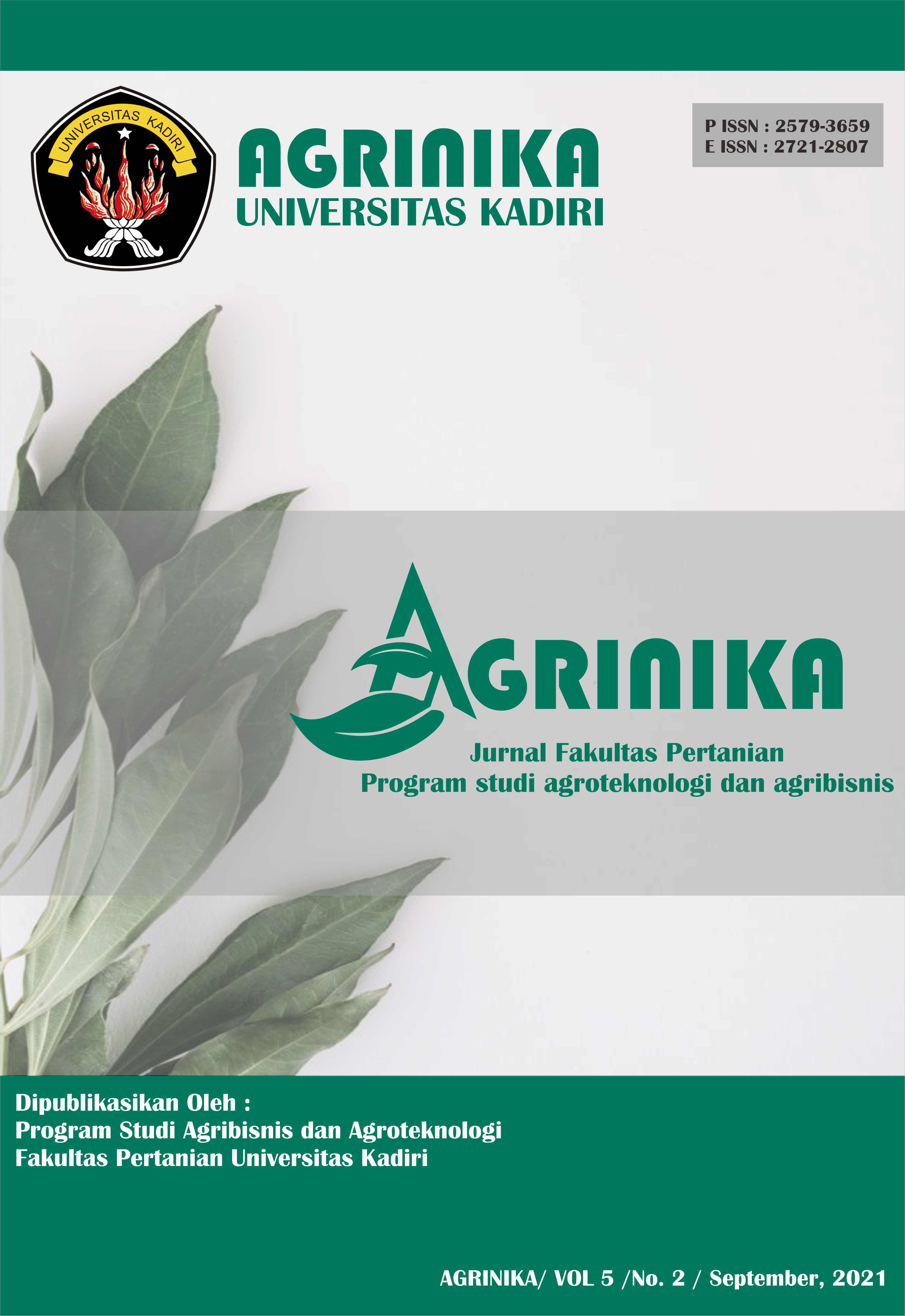Antioxidant Activity of Non-Volatile Lime (Citrus aurantifolia Swingle) Extract
DOI:
https://doi.org/10.30737/agrinika.v5i2.1919Keywords:
antioxidant, Citrus aurantifolia, DPPH, zero-waste industryAbstract
The paper reports the antioxidant activity of a non-volatile fraction of lime processing byproducts from the lime syrup home industry. The activity was measured by spectrophotometry to obtain the 50% inhibition concentration (IC50) using the 2,2- diphenyl-1-picrylhydrazyl (DPPH) method. The sample was extracted by the maceration method with n-hexane, ethyl-acetate, and ethyl-ethanol. The IC50 values of 681 ppm, 458 ppm, and 2,775 ppm were n-hexane, ethyl-acetate, and ethyl-ethanol. The experiments concluded that the ethyl-acetate extract provides the best inhibition value to scavenge free-radicals DPPH. The HPLC and mass spectroscopy were measured to find out the content and group of active compounds. The significant compounds consisted of naringin, poncirin, or neoponcirin, which are known as antioxidant substances. The result shows the potential application of the lime by-products, its volatile fraction, and the nonvolatile fraction, which is the production residue of lime peel. This work can be applied as an alternative to zero-waste lime production, which may benefit the industry and the environment.References
Chen, X. M., Tait, A. R., & Kitts, D. D. (2017). Flavonoid composition of orange peel and its association with antioxidant and anti-inflammatory activities. Food Chemistry, 218, 15–21. http://doi.org/10.1016/j.foodchem.2016.09.016
Loizzo, M. R., Tundis, R., Bonesi, M., Menichini, F., De Luca, D., Colica, C., & Menichini, F. (2012). Evaluation of Citrus aurantifolia peel and leaves extracts for their chemical composition, antioxidant and anti-cholinesterase activities. Journal of the Science of Food and Agriculture, 92(15), 2960–2967. http://doi.org/10.1002/jsfa.5708
Maemulyati, A., & A. R. Prihadi. (2016). Chemical composition of essential oil and hexane extract and antioxidant activity of various extracts of Acmella uliginosa (Sw.) Cass flowers from Indonesia. Agriculture and Natural Resources, 50(4), 264–269.
Safdar, M. N., Kausar, T., Jabbar, S., Mumtaz, A., Ahad, K., & Saddozai, A. A. (2017). Extraction and quantification of polyphenols from kinnow (Citrus reticulate L.) peel using ultrasound and maceration techniques. Journal of Food and Drug Analysis, 25(3), 488–500. http://doi.org/10.1016/j.jfda.2016.07.010
Samira Lagha-Benamrouche, & Madania, K. (2013). Phenolic contents and antioxidant activity of orange varieties (Citrus sinensis L. and Citrus aurantium L.) cultivated in Algeria: Peels and leaves. Industrial Crops and Products, 50, 723–730.
Shofinita, D., Feng, S., & Langrish, T. A. G. (2015). Comparing yields from the extraction of different citrus peels and spray drying of the extract. Advanced Powder Technology, 26(6), 1633–1638.
Xia, W., Fanga, B. B., Zhaob, Q., Jiaob, B., & Zhoua, Z. (2014). Flavonoid composition and antioxidant activities of Chinese local pummelo (Citrus grandis Osbeck.) varieties. Food Chemistry, 162, 230–238.
Zhuo Zou, Wanpeng Xi, Yan Hu, Chao Nie, Z. Z. (2016). Antioxidant activity of Citrus fruits. Food Chemistry, 196, 885–896.
Downloads
Additional Files
Published
Issue
Section
License
Authors who publish in this journal agree to the following terms:
- Authors retain copyright with the work simultaneously licensed under a Creative Commons Attribution License (https://creativecommons.org/licenses/by-nc-nd/4.0/) that allows others to share the work with an acknowledgement of the work's authorship and initial publication in this journal. Permitted third-party reuse is defined by the Creative Commons Attribution-NonCommercial-NoDerivs (CC BY-NC-ND). This permission allows users to copy and distribute the Article, provided this is not done for commercial purposes and further does not permit distribution of the Article if it is changed or edited in any way, and provided the user gives appropriate credit (with a link to the formal publication through the relevant DOI), provides a link to the license, and that the licensor is not represented as endorsing the use made of the work.
- Authors are able to enter into separate, additional contractual arrangements for the non-exclusive distribution of the journal's published version of the work (e.g., post it to an institutional repository or publish it in a book), with an acknowledgement of its initial publication in this journal.
- Authors are permitted and encouraged to post their work online (e.g., in institutional repositories or on their website) prior to and during the submission process, as it can lead to productive exchanges, as well as earlier and greater citation of published work.








